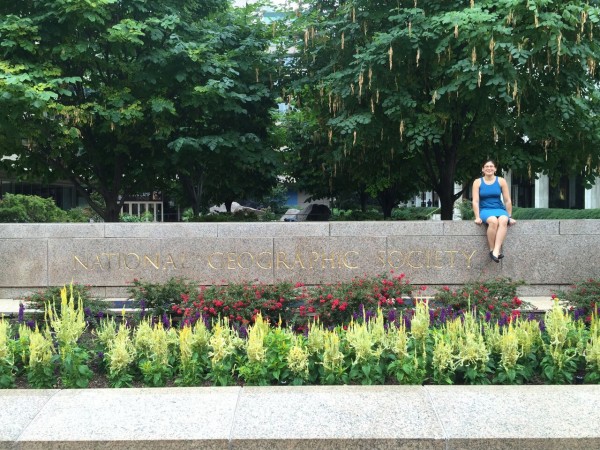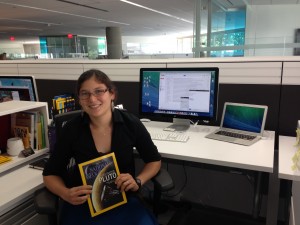12 October 2015
Riding a “Roller Coaster” at National Geographic
Posted by mcadams

Maya Wei-Haas, AGU’s 2015 Mass Media Fellow, sits on a wall outside the National Geographic building in Washington, D.C., where she spent 10 weeks this summer working as a science reporter. Photo by Dione Rossiter, AAAS.
By Maya Wei-Haas
The elevator dings and I step out, glancing one last time at the historical black-and-white photos lining the corridor one floor below the National Geographic offices. I wander down the dim hallway and enter an office with a sign marked “security.” Reluctantly, I hand over my credentials that identify me as a member of the National Geographic family.
“Is that it?” I ask the security guard at the desk.
“That’s it,” he says.
That moment marked the end of my roller coaster ride in a fellowship program with the American Association for the Advancement of Science (AAAS) in which scientists work summer stints as reporters in news outlets across the country.
Fellows in the AAAS Mass Media Science and Engineering Fellows Program learn how to communicate science to the public and, at the same time, lend valuable scientific expertise to newsrooms.
The American Geophysical Union (AGU) sponsored me in this intense 10-week welcome to the ups and downs of journalism.
Need for Speed
Writing breaking news is a sprint: contacting experts, scanning published coverage, and pounding out 600 words or less in a matter of hours. My heart often raced as I wrote these articles. One afternoon, with only a couple of hours to deliver a story about the Curiosity rover’s third anniversary on Mars, my editor and I worked on the document simultaneously: She edited each section immediately after I wrote it.
Writing about scientific papers moves at a slower pace, requiring finesse to transform complex research into conversational stories. As the reporter, I sifted through details, extracting only the most salient points and incorporating just enough background to help the audience understand the science.
Although more leisurely to produce than breaking news, these paper-centric stories don’t rank as the slow food of the journalism world. Reporters get access to peer-reviewed articles for only a short period at best before public release. Stories must be polished and ready to go as soon as any embargo lifts, else risk getting buried under a barrage of timelier pieces.
Across my National Geographic desk also came stunning photos or viral videos and the task of quickly explaining their underlying science in a light-hearted, punchy article.
Last, there were enterprise stories, as my editor called them—bigger projects like writing up a budding field of research or digging into some intriguing scientific question triggered by other discoveries. Those were the toughest stories for me to discover and develop from the endless and ever-changing mass of scientific literature. But they could be the most rewarding to write.
Highs and Lows
Every flavor of story at National Geographic offered its own subtleties and joys. And I savored each one that came my way. (Click here to read my stories from the National Geographic newsroom.)
I’m not saying the fellowship wasn’t a challenge. During this thrilling ride, there were definitely times when it seemed to go off the rails. For one week in the middle of the summer, everything ground to a halt. I just couldn’t find a story to write and ended each day with the sinking feeling that I was an imposter. But by the end of my 10 weeks as a reporter, I started to fall into a rhythm, savoring the anticipation of mounting each hill and then joyfully plunging into another madcap assignment.

Maya Wei-Haas holds up a copy of National Geographic at her desk at the magazine where she wrote science stories this summer as AGU’s 2015 Mass Media Fellow. Credit: Greta Weber
To Do or Not to Do
On my last day at National Geographic, one of my editors asked me to write about one last viral video—this one of a great white shark that was supposedly the largest ever filmed. As I scrambled to find experts to interview and assembled my notes into a story, I kept thinking how I never wanted this to end.
I love doing science: the instruments quietly humming in the lab, with their promise of eye-opening data; the endless sizes and shapes of glassware, begging for creative experiments; the trials and tribulations of fieldwork in unspeakably gorgeous locations.
But this summer I discovered that even more than doing science, I love using science to explain all the amazing and puzzling oddities of our world to anyone willing to listen.
Though turning over my badge at the National Geographic security office felt like the end of an epic adventure, my story is not over yet. This month I start as an assistant editor for Smithsonian.com.
— Maya Wei-Haas, now an assistant editor for science and innovation at Smithsonian.com, is AGU’s 2015 Mass Media Science and Engineering Fellow. She spent her 10-week fellowship at National Geographic in Washington, D.C. Wei-Haas earned her Ph.D. in geology from Ohio State University this May. Click here to read her stories from the National Geographic newsroom.
This post originally appeared on Eos.org on 16 September 2015.


 The Plainspoken Scientist is the science communication blog of AGU’s Sharing Science program. With this blog, we wish to showcase creative and effective science communication via multiple mediums and modes.
The Plainspoken Scientist is the science communication blog of AGU’s Sharing Science program. With this blog, we wish to showcase creative and effective science communication via multiple mediums and modes.